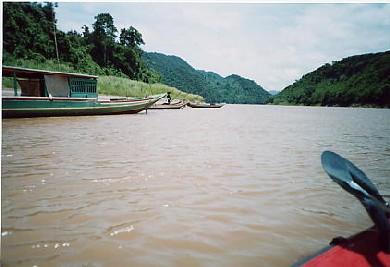

Mekong, Day 1
Fishing boats
This was taken some hours after I left Luang Prabang, heading south
and passing by a small fishing
village on the left.
The water was visibly muddy.
.
.
.
.
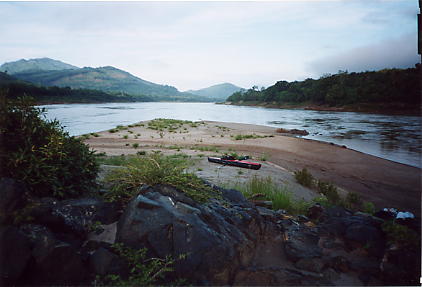
Mekong, Day 2
Dawn on a sandbar
On first night, I found a nice camp site on a sandbar in the middle of the river. This was taken on the morning after. In this view, we are looking southward, downstream of the river.
.
.
.
.
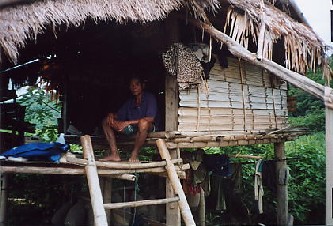
Mekong, Day 4
My fisherman host at his home
On the 2nd and 4th nights, I stayed with families living on the
river bank. On the 4th night, I stayed with a fisherman whose children have
left and is living by himself. His home is a simple hut made of logs and
bamboo poles tied together, with a palm leaf roof. The hut has a sleeping
area, a cooking area, and a sitting area.
The cooking area has a hearth made of rocks over which cooking is done over open fire.
Around the hut is a vegetable/fruit garden and a view down to
the river, where his fishing boat (as is typical on the Mekong,
the boat, made of wooden planks, is long, narrow, has a shallow draft,
and is paddled
like a canoe) is moored.
Fishing nets hung on the side
of the hut. Ants were everywhere.
For the evening meal, we had sticky rice, grounded green chili pepper,
and certain vegetable (tomato-like, but light green with a very firm whitish pulp).
We were later joined by other fishermen living nearby, who proceeded to
use my Lao phrase book to teach me Lao under candle light. For the meal next morning,
my host cooked (in a wicker basket over an iron pot) sticky rice and
grilled small fishes caught the day before. He shared what he had.
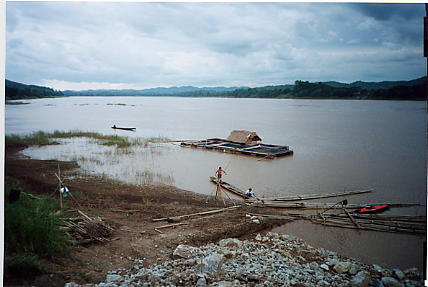
Mekong, Day 5
Mooring at river bank
On the 5th day, the river is now headed eastward, with Laos on the north bank and Thailand on the south bank. I have stopped at the charming town of Chiang Khan in Thailand and have moored my kayak at a dock for fishing boats. No one seemed to mind. A fishing boat with two man aboard is docking nearby. Another fishing boat is further back, still out on the river.
.
.
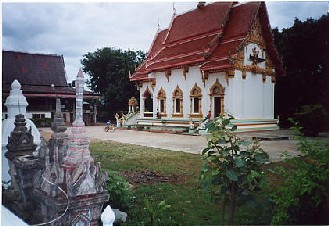
Mekong, Day 5
A Buddhist Temple
Buddhism has a strong tradition in both Laos and Thailand. Thailand seems to have channeled the output of its economic growth into temple (re)building. Here is a beautiful little example in Chiang Khan.
.
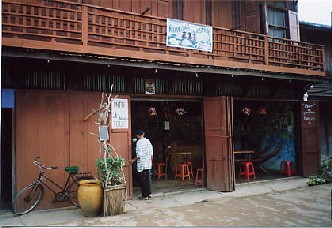
Mekong, Day 5
Guest maison
On reaching Chiang Khan, I asked a boatman about accomodation and was referred to a nearby guest house. The guest house turned out to have a French owner (away in France), a French bartender, and French guests. My French was rusty, but they were good enough to switch to English when needed.
.
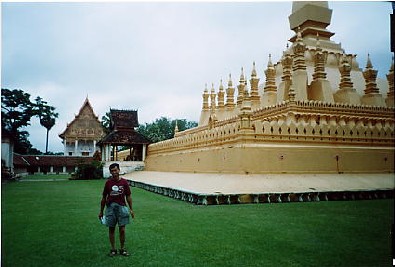
Mekong, Day 7
A golden stupa, Vientiane
After joining a Thai wedding celebration and sleeping in a police barrack the night before, I reached Vientiane on the afternoon of day 7. In the photo I am standing next to the Great Sacred Stupa of Pha That Luang in Vientiane. My kayaking journey ended here. For more details, click here.
.
.
.